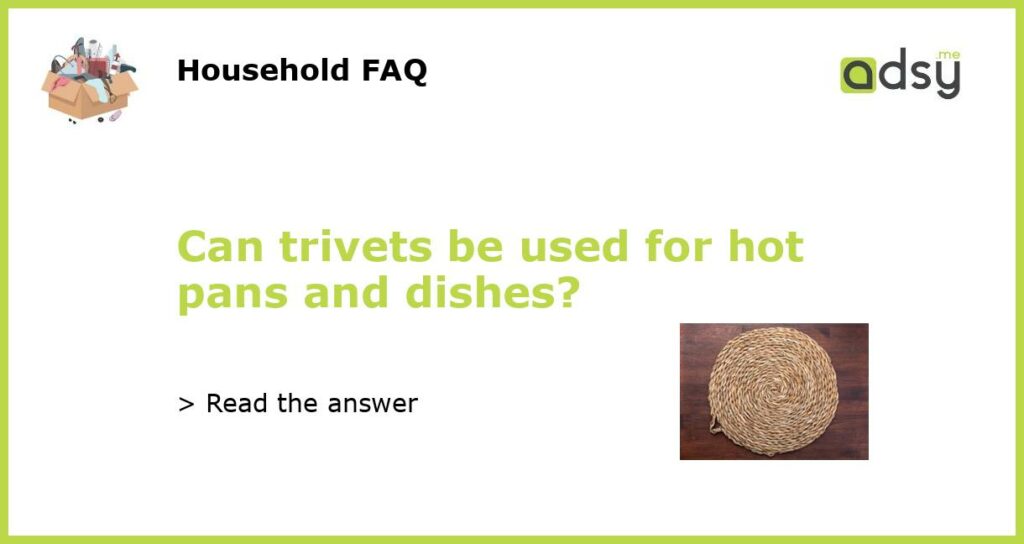Yes, trivets can be used for hot pans and dishes
Trivets are commonly used in kitchens to protect countertops and tables from high heat. Their main function is to provide a stable, heat-resistant surface for placing hot pans, dishes, and other cookware. Trivets are typically made from materials such as stainless steel, cast iron, silicone, or cork, which can withstand high temperatures without melting or warping.
Material and Design Considerations
The material and design of a trivet can affect its heat resistance and effectiveness in protecting surfaces. Stainless steel and cast iron trivets are known for their durability and high heat resistance. They are often designed with raised patterns or grids to allow air circulation and prevent direct contact between the hot cookware and the surface. Silicone trivets are flexible and heat-resistant, providing excellent protection against heat transfer.
Cork trivets, on the other hand, are more commonly used for serving dishes at the table rather than for directly placing hot pans. While cork can withstand moderate heat, it is not as heat-resistant as stainless steel or silicone. Additionally, the design of the trivet may also affect its heat resistance. Trivets with thicker materials and higher raised patterns tend to provide better insulation and protection against heat transfer.
Advantages of Using a Trivet
Using a trivet can offer several advantages when handling hot pans and dishes:
- Protection: Trivets prevent direct contact between the hot cookware and the surface, protecting it from heat damage. This is especially important for delicate surfaces such as wood, marble, or laminate countertops.
- Heat Distribution: Trivets help distribute the heat evenly across the bottom of the pan or dish, ensuring more uniform cooking or warming of the food.
- Stability: Trivets provide a stable and secure platform for placing hot pans, reducing the risk of accidents from tipping or spilling.
- Prevention of Moisture Damage: Trivets can also protect surfaces from condensation or moisture that may accumulate underneath the hot cookware.
- Enhanced Aesthetics: Trivets come in a variety of designs and materials, allowing you to add a touch of style to your kitchen while protecting your surfaces.
Alternatives to Trivets
If you don’t have a trivet on hand or prefer not to use one, there are alternative options for protecting your countertops and tables from hot pans and dishes:
- Potholders or Oven Mitts: Potholders or oven mitts can be used to hold and carry hot cookware. However, they are not suitable for long-term placement as they do not provide a stable surface like a trivet.
- Towels or Dishcloths: Placing a thick towel or dishcloth underneath a hot pan can offer some protection against heat transfer. However, be cautious as these materials can absorb moisture and may not be as effective in preventing heat damage.
- Cutting Boards: Thick wooden or bamboo cutting boards can be used as a makeshift trivet. Ensure that the cutting board is clean and free from any moisture or food particles before using it as a heat-resistant surface.
Caring for Trivets
To ensure the longevity and effectiveness of your trivet, it is important to care for it properly:
- Cleaning: After each use, wipe the trivet clean with a damp cloth or sponge. Avoid using abrasive cleaners or scouring pads that can damage the material.
- Drying: Allow the trivet to air dry completely before storing it. Moisture trapped between the trivet and the surface can lead to mold or mildew growth.
- Storage: Store your trivet in a dry and cool location to prevent any warping or damage from excessive heat or moisture.
- Inspecting: Regularly inspect your trivet for any signs of wear, damage, or loose parts. Replace it if necessary to maintain its functionality and safety.
By using a trivet, you can effectively protect your countertops and tables from the heat of pans and dishes. Trivets provide stability, heat resistance, and insulation, allowing you to handle hot cookware with confidence and prevent damage to your surfaces. Whether you opt for a stainless steel, cast iron, silicone, or cork trivet, make sure to care for it properly to ensure its durability and effectiveness over time.






